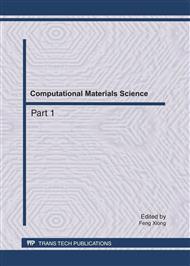[1]
P. Viola, M. J. Jones, D. Snow: Detecting pedestrians using patterns of motion and appearance. The 9th ICCV, Nice, France, Vol. 1, pp.734-741, (2003).
DOI: 10.1109/iccv.2003.1238422
Google Scholar
[2]
R. Lienhart: An extended set of Haar-like features for rapid object detection. Processing of the IEEE International Conference on Image, Dec. 2002, Vol. 1, pp.900-903, (2002).
DOI: 10.1109/icip.2002.1038171
Google Scholar
[3]
N. Dalal, B. Triggs: Histograms of Oriented Gradients for Human Detection. Proceedings of the IEEE Conference on Computer Vision and Pattern Recognition, June 2005, San Diego, USA, Vol. II, pp.886-893, (2005).
DOI: 10.1109/cvpr.2005.177
Google Scholar
[4]
M. Enzweiler, D. Gavrila: Monocular pedestrian detection: Survey and experiments. IEEE Trans. on Pattern Analysis and Machine Intelligence, Vol. 31, pp.2179-2195, (2009).
DOI: 10.1109/tpami.2008.260
Google Scholar
[5]
S. Kang: Real-time Pedestrian deteetion using support vector machines. International Journal of Pattem Reeognition and Artifieial Intelligenee, Vol. 17, pp.405-416, (2003).
Google Scholar
[6]
H. Cheng, N. Zheng, J. Qin: Pedestrian Detection Using Sparse Gabor Filter and Support Vector Machine. IEEE Intelligent Vehicles Symposium, June 2005, USA, pp.583-587, (2005).
DOI: 10.1109/ivs.2005.1505166
Google Scholar
[7]
L. Yulan, M. L. Reyes, J. D. Lee: Real-Time Detection of Driver Cognitive Distraction Using Support Vector Machines. IEEE Trans. on Intelligent Transportation Systems, Vol. 8, pp.340-350, (2007).
DOI: 10.1109/tits.2007.895298
Google Scholar
[8]
G. Zhang, B. Cheng, R. Feng, J. Li: Real-time Driver Eye Detection Method Using Support Vector Machine with Hu Invariant Moments. International Conference on Machine Learning and Cybernetics, Vol. 5, pp.2999-3004, (2008).
DOI: 10.1109/icmlc.2008.4620921
Google Scholar
[9]
L. Zhao, C. Thorpe: Stereo and neural network-based pedestrian detection. IEEE Trans. on Intelligent Transportation Systems, Vol. l(3), pp.148-154, (2000).
DOI: 10.1109/6979.892151
Google Scholar
[10]
U. Franke, A. Joos: Real-time stereo vision for urban traffic scene understanding. IEEE Intelligent Vehicles Symposium, Dearborn, pp.273-278, (2000).
DOI: 10.1109/ivs.2000.898354
Google Scholar
[11]
M. Szaras, A. Yoshizawa, M. Yamamoto, J. Ogata: Pedestrian detection with convolutional neutral networks. IEEE Intelligent Vehicles Symposium, Las Vegas, Nevada, pp.224-229, (2005).
DOI: 10.1109/ivs.2005.1505106
Google Scholar
[12]
P. Viola, M. Jones: Rapid Object Detection using a Boosted Cascade of Simple Features. IEEE Computer Society on Computer Vision and Pattern Recognition, Dec. 2001, Vol. 1, pp.511-518, (2001).
DOI: 10.1109/cvpr.2001.990517
Google Scholar


